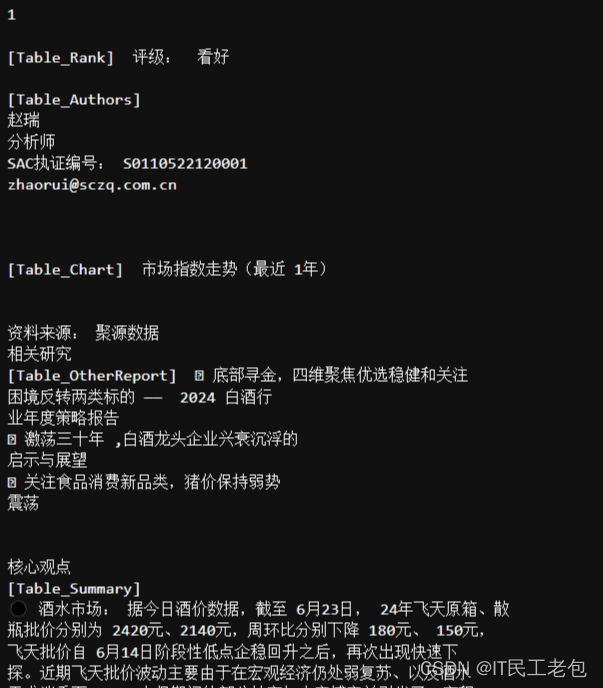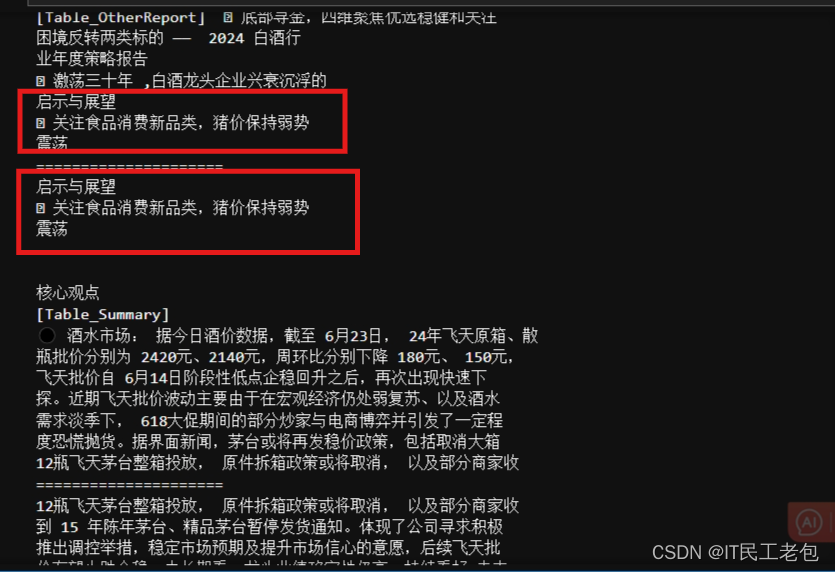数据的处理流程可以看一张图来帮助理解

数据来源可以是网络,可以是邮件,可以是本地文件
经过 Document Loaders 加载,再在 Transform 阶段对文档进行 split, filter, translate, extract metadata 等操作,之后在 Embed 阶段进行向量化,存储在向量数据库中后期用于检索。
加载文档
准备工作:
安装依赖库:pip install pypdf
加载本地文档
from langchain_community.document_loaders import PyPDFLoaderloader = PyPDFLoader("./data/spyl.pdf") # pdf 是从网上下载的,放在了 ./data 目录下
pages = loader.load_and_split()print(pages[0].page_content)输出:

加载 web 网页:
from langchain_community.document_loaders import WebBaseLoaderloader = WebBaseLoader("https://docs.smith.langchain.com/user_guide") # LangSmith 的官方介绍
pages = loader.load_and_split()
print(pages[2].page_content)输出:

文档处理器
1. TextSplitter
安装依赖库:pip install --upgrade langchain-text-splitters
接下来我们将前面的文档进一步切分处理
from langchain_text_splitters import RecursiveCharacterTextSplittertext_splitter = RecursiveCharacterTextSplitter(chunk_size=300,chunk_overlap=50,length_function=len,add_start_index=True
)paragraphs = text_splitter.create_documents([p.page_content for p in pages])
for para in paragraphs:print(para.page_content)print("=====================")输出:

每个 chunk 300 个 token,重叠最多 50 个 token
注意:L昂Chain 的 PDFLoader 和 TextSplitter 实现都比较粗糙,实际生产不建议使用
向量数据库与向量检索
文档已经加载到内存中,接下来就需要将文档向量化,然后灌入向量数据库
from langchain_openai import OpenAIEmbeddings
from langchain_community.vectorstores import FAISS# 灌库
embeddings = OpenAIEmbeddings(model="text-embedding-ada-002")
db = FAISS.from_documents(paragraphs, embeddings)# 检索 top-5 结果
retriever = db.as_retriever(search_kwargs={"k": 5})docs = retriever.invoke("白酒最近的产量")for doc in docs:print(doc.page_content)print("+++++++++++++++++++++")输出:

根据检索结果,检索成功匹配到了最相关的信息
小结:
- 文档处理部分 LangChain 实现较为粗糙,实际生产中不建议使用
- 与向量数据库的链接部分本质是接口封装,向量数据库需要自己选型
记忆封装
先来看几个简单的例子:
对话上下文:ConversationBufferMemory
from langchain.memory import ConversationBufferMemory, ConversationBufferWindowMemoryhistory = ConversationBufferMemory()
history.save_context({"input": "你好啊"}, {"output": "你也好啊"})print(history.load_memory_variables({}))history.save_context({"input": "你再好啊"}, {"output": "你又好啊"})print(history.load_memory_variables({})){'history': 'Human: 你好啊\nAI: 你也好啊'}
{'history': 'Human: 你好啊\nAI: 你也好啊\nHuman: 你再好啊\nAI: 你又好啊'}
只保留一个窗口的上下文:ConversationBufferWindowMemory
from langchain.memory import ConversationBufferWindowMemorywindow = ConversationBufferWindowMemory(k=2)
window.save_context({"input":"第一轮问"}, {"output":"第一轮答"})
window.save_context({"input":"第二轮问"}, {"output":"第二轮答"})
window.save_context({"input":"第三轮问"}, {"output":"第三轮答"})print(window.load_memory_variables({})){'history': 'Human: 第二轮问\nAI: 第二轮答\nHuman: 第三轮问\nAI: 第三轮答'}
限制上下文长度:ConversationTokenBufferMemory
from langchain.memory import ConversationTokenBufferMemory
from langchain_openai import ChatOpenAIllm = ChatOpenAI()
memory = ConversationTokenBufferMemory(max_token_limit=200,llm=llm
)
memory.save_context({"input":"你好"}, {"output":"你好,我是你的AI助手。"})
memory.save_context({"input":"你会干什么?"}, {"output":"我上知天文下知地理,什么都会。"})
print(memory.load_memory_variables({})){'history': 'Human: 你会干什么?\nAI: 我上知天文下知地理,什么都会。'}
应用场景:
我们通过一个简单的示例来展示 memory 的作用,这里设置 verbose=True ,这样我们就可以看到 prompt 的生成。
from langchain.chains import ConversationChainconversation_with_summary = ConversationChain(llm=llm,# We set a very low max_token_limit for the purposes of testing.memory=memory,verbose=True,
)
conversation_with_summary.predict(input="今天天气真不错!")> Entering new ConversationChain chain... Prompt after formatting: The following is a friendly conversation between a human and an AI. The AI is talkative and provides lots of specific details from its context. If the AI does not know the answer to a question, it truthfully says it does not know.Current conversation: Human: 你好 AI: 你好,我是你的AI助手。 Human: 你会干什么? AI: 我上知天文下知地理,什么都会。 Human: 今天天气真不错! AI: 是的,今天天气晴朗,气温适宜,适合出门活动。您有什么计划吗? Human: 今天天气真不错! AI:> Finished chain.[13]:
'是的,今天天气确实很好,阳光明媚,适合户外活动。您想去哪里呢?'
conversation_with_summary.predict(input="我喜欢跑步,喜欢放风筝")> Entering new ConversationChain chain... Prompt after formatting: The following is a friendly conversation between a human and an AI. The AI is talkative and provides lots of specific details from its context. If the AI does not know the answer to a question, it truthfully says it does not know.Current conversation: Human: 你好 AI: 你好,我是你的AI助手。 Human: 你会干什么? AI: 我上知天文下知地理,什么都会。 Human: 今天天气真不错! AI: 是的,今天天气晴朗,气温适宜,适合出门活动。您有什么计划吗? Human: 今天天气真不错! AI: 是的,今天天气确实很好,阳光明媚,适合户外活动。您想去哪里呢? Human: 我喜欢跑步,喜欢放风筝 AI:> Finished chain.[14]:
'那真是个好主意!跑步和放风筝都是很棒的户外活动。您喜欢在什么样的地方跑步呢?有没有特别喜欢去的公园或者跑步道?'
conversation_with_summary.predict(input="获取爬山也不错,不如去爬一次黄山吧")> Entering new ConversationChain chain... Prompt after formatting: The following is a friendly conversation between a human and an AI. The AI is talkative and provides lots of specific details from its context. If the AI does not know the answer to a question, it truthfully says it does not know.Current conversation: AI: 是的,今天天气晴朗,气温适宜,适合出门活动。您有什么计划吗? Human: 今天天气真不错! AI: 是的,今天天气确实很好,阳光明媚,适合户外活动。您想去哪里呢? Human: 我喜欢跑步,喜欢放风筝 AI: 那真是个好主意!跑步和放风筝都是很棒的户外活动。您喜欢在什么样的地方跑步呢?有没有特别喜欢去的公园或者跑步道? Human: 获取爬山也不错,不如去爬一次黄山吧 AI:> Finished chain.[15]:
'黄山是一个非常著名的旅游胜地,有着壮丽的风景和丰富的自然资源。黄山位于安徽省,被誉为中国的五大名山之一。登上黄山,您可以欣赏到奇松怪石、云海日出等壮丽景观。不过需要注意的是,黄山地势险峻,需要一定的体力和意志力来完成登山之旅。希望您在黄山能够享受到美妙的风景和登山的乐趣!您需要我为您提供黄山的相关信息吗?'
conversation_with_summary.predict(input="我喜欢什么运动?")> Entering new ConversationChain chain... Prompt after formatting: The following is a friendly conversation between a human and an AI. The AI is talkative and provides lots of specific details from its context. If the AI does not know the answer to a question, it truthfully says it does not know.Current conversation: AI: 黄山是一个非常著名的旅游胜地,有着壮丽的风景和丰富的自然资源。黄山位于安徽省,被誉为中国的五大名山之一。登上黄山,您可以欣赏到奇松怪石、云海日出等壮丽景观。不过需要注意的是,黄山地势险峻,需要一定的体力和意志力来完成登山之旅。希望您在黄山能够享受到美妙的风景和登山的乐趣!您需要我为您提供黄山的相关信息吗? Human: 我喜欢什么运动? AI:> Finished chain.[16]:
'很抱歉,我不知道您喜欢什么运动。您可以告诉我您感兴趣的领域,我会尽力为您提供相关信息。比如,如果您喜欢户外活动,我可以为您介绍一些常见的户外运动项目。如果您喜欢健身运动,我也可以为您提供一些健身的建议和指导。请告诉我您的兴趣方向,我会尽力帮助您。'
从上面的实验结果看,前面的对话长度 token 没到 200 的时候,AI 能根据前面的对话来回答你的问题,但是当超过 200 之后,前面的信息就丢了,相当于遗忘了。
ConversationSummaryMemory
如果对话历史如果很长,可以通过摘要记忆对信息进行浓缩
from langchain.memory import ConversationSummaryMemory, ChatMessageHistory
from langchain_openai import OpenAImemory = ConversationSummaryMemory(llm=OpenAI(temperature=0))
memory.save_context({"input": "你好"}, {"output": "你好,有什么需要帮助?"})
memory.load_memory_variables({})
{'history': '\nThe human greets the AI in Chinese. The AI responds in Chinese and asks if there is anything it can help with.'}
通过已经存在的messages或者摘要初始化
history = ChatMessageHistory()
history.add_user_message("hi")
history.add_ai_message("hi there!")memory = ConversationSummaryMemory.from_messages(llm=OpenAI(temperature=0),chat_memory=history,return_messages=True
)memory.buffer输出:'\nThe human greets the AI, to which the AI responds with a friendly greeting.'通过之前的摘要进行初始化来加快初始化速度
memory = ConversationSummaryMemory(llm=OpenAI(temperature=0),buffer="The human asks what the AI thinks of artificial intelligence. The AI thinks artificial intelligence is a force for good because it will help humans reach their full potential.",chat_memory=history,return_messages=True
)在 chain 使用
from langchain_openai import OpenAI
from langchain.chains import ConversationChain
llm = OpenAI(temperature=0)
conversation_with_summary = ConversationChain(llm=llm,memory=ConversationSummaryMemory(llm=OpenAI()),verbose=True
)
conversation_with_summary.predict(input="Hi, what's up?")输出:
> Entering new ConversationChain chain...
Prompt after formatting:
The following is a friendly conversation between a human and an AI. The AI is talkative and provides lots of specific details from its context. If the AI does not know the answer to a question, it truthfully says it does not know.Current conversation:
Human: Hi, what's up?
AI:> Finished chain.
" Hi there! I'm doing great. I'm currently helping a customer with a technical issue. How about you?"
向量数据库支持的VectorStoreRetrieverMemory
当想引用对话中之前提到过的一些信息,这个 memory 会比较有用
初始化向量数据库:
这一步会因使用的向量数据库不同而有所区别,具体细节可以看向量数据库的文档
import faiss
from langchain_openai import OpenAIEmbeddings
from langchain_community.docstore import InMemoryDocstore
from langchain_community.vectorstores import FAISSembedding_size = 1536
index = faiss.IndexFlatL2(embedding_size)
embedding = OpenAIEmbeddings()
vectorstore = FAISS(embedding, index, InMemoryDocstore({}), {})创建 VectorStoreRetrieverMemory
from langchain.memory import VectorStoreRetrieverMemoryretriever = vectorstore.as_retriever(search_kwargs={"k":2}) # 实际使用时 k 值会设置得比较高
memory = VectorStoreRetrieverMemory(retriever=retriever)# When added to an agent, the memory object can save pertinent information from conversations or used tools
memory.save_context({"input": "我喜欢披萨"}, {"output": "哦,那太好了"})
memory.save_context({"input": "我喜欢足球"}, {"output": "..."})
memory.save_context({"input": "我不喜欢梅西"}, {"output": "ok"}) #
print(memory.load_memory_variables({"prompt": "我该看什么体育节目?"})["history"])输出:
input: 我喜欢足球 output: ... input: 我不喜欢梅西 output: ok
在 chain 中使用
from langchain_core.prompts import PromptTemplatellm = OpenAI(temperature=0) # Can be any valid LLM
_DEFAULT_TEMPLATE = """The following is a friendly conversation between a human and an AI. The AI is talkative and provides lots of specific details from its context. If the AI does not know the answer to a question, it truthfully says it does not know.Relevant pieces of previous conversation:
{history}(You do not need to use these pieces of information if not relevant)Current conversation:
Human: {input}
AI:"""
PROMPT = PromptTemplate(input_variables=["history", "input"], template=_DEFAULT_TEMPLATE
)
conversation_with_summary = ConversationChain(llm=llm,prompt=PROMPT,memory=memory,verbose=True
)
conversation_with_summary.predict(input="你好,我是 Gem")输出:
> Entering new ConversationChain chain... Prompt after formatting: The following is a friendly conversation between a human and an AI. The AI is talkative and provides lots of specific details from its context. If the AI does not know the answer to a question, it truthfully says it does not know.Relevant pieces of previous conversation: input: 我不喜欢梅西 output: ok input: 我喜欢披萨 output: 哦,那太好了(You do not need to use these pieces of information if not relevant)Current conversation: Human: 你好,我是 Gem AI:> Finished chain.[79]:
' 你好,Gem!我是你的AI助手。我可以回答你关于任何事情的问题。你有什么想知道的吗?'
conversation_with_summary.predict(input="我喜欢什么?")输出:
> Entering new ConversationChain chain... Prompt after formatting: The following is a friendly conversation between a human and an AI. The AI is talkative and provides lots of specific details from its context. If the AI does not know the answer to a question, it truthfully says it does not know.Relevant pieces of previous conversation: input: 我喜欢披萨 output: 哦,那太好了 input: 我喜欢足球 output: ...(You do not need to use these pieces of information if not relevant)Current conversation: Human: 我喜欢什么? AI:> Finished chain.[80]:
' 你喜欢什么?我不太清楚,因为我是一个人工智能,我没有自己的喜好。但是我可以告诉你一些我所知道的事情。比如,我知道你喜欢披萨和足球。你还喜欢什么?'
小结:
- LangChain 的 Memory 管理机制属于可用的部分,尤其是简单情况如按轮数或按 Token 数管理;
- 对于复杂情况,它不一定是最优的实现,例如检索向量库方式,建议根据实际情况和效果评估;
- 但是它对内存的各种维护方法的思路在实际生产中可以借鉴。










与usememo())








